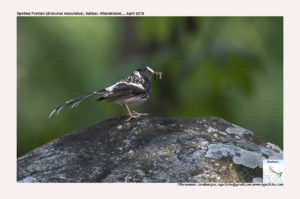Spotted Forktail

Spotted Forktail Enicurus maculatus
Etymology :
- Enicurus : Greek word henikos – singular; ouros -tailed
- Maculatus : Latin word macula – spot { Spotted}
Vernacular Names: Baluchistan: Khanjan, Kash: Shakhel-lot, Lepcha: Oong-sam ching-pho, Bhutia: Chuka-leka
Distribution in India: Resident of Himalayas and North East India
Description: Size of 27-28 cm. It has white forehead, fore crown; black crown, nape; black back spotted white; broad, white wing-bar, rump; deeply forked, graduated black and white tail; black till breast, white below.
Habitat: It is found in small sheltered streams and rivulets, preferably with strewn emergent rocks, tiny pools, tinkling waterfalls and shadowed banks, running through dense forest, wooded gorges and ravines. Breeds at 600–3000 m; winters in lowlands and foothills.
Food Habits: It eats aquatic insects and their larvae, and small molluscs. Caterpillars and an adult cranefly are brought to nestlings. It forages on ground, working steadily upstream, in and around streambed, sometimes entering water up to breast level, but usually searching gaps between stones at water’s edge and entering holes under rocks. It also makes brief aerial jumps after flying insect and turns over stones and foot-paddle to disturb the prey
Breeding Habits: They breed in Feb-Jun. The nest is a neat but substantial cup of living wet moss and moss roots with clay intermixed, lined with leaf skeletons, placed generally in wet, water-splashed place, often directly over running water, in hole in rock or bank,. They lay a clutch of 3-4 eggs. Both parents incubate the eggs for 3 weeks. Nest is often parasitized by Common Cuckoo